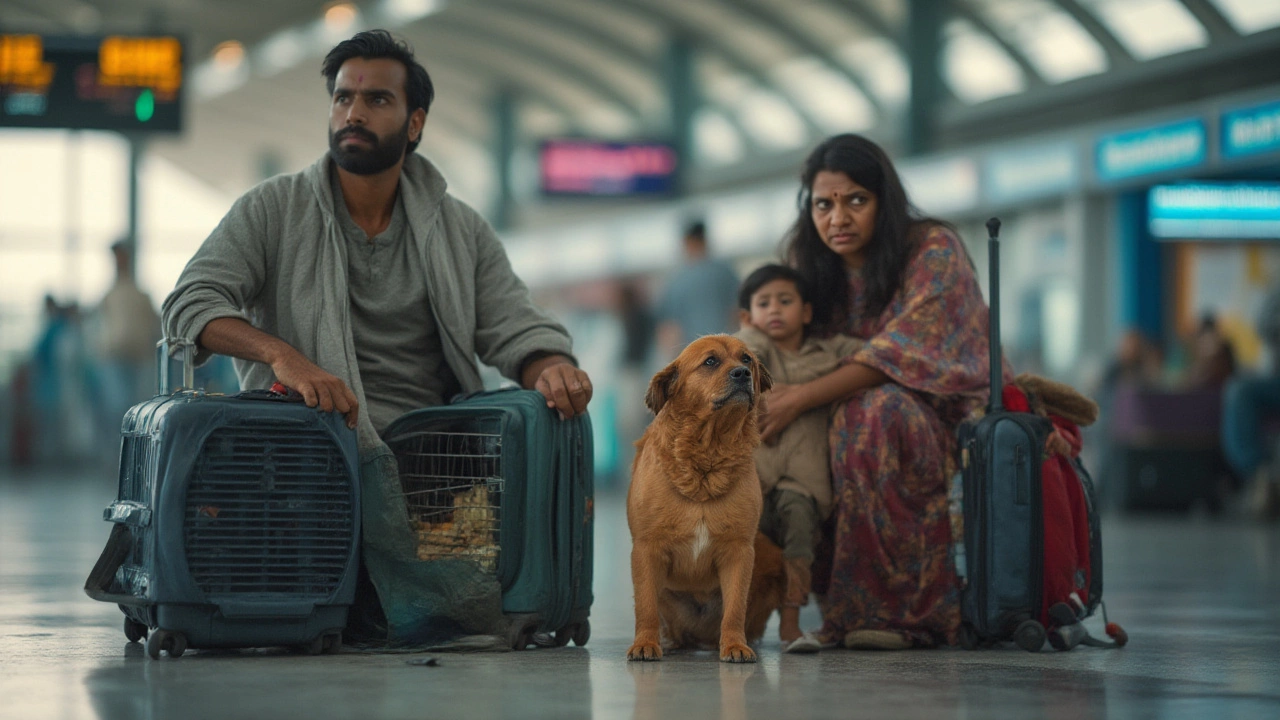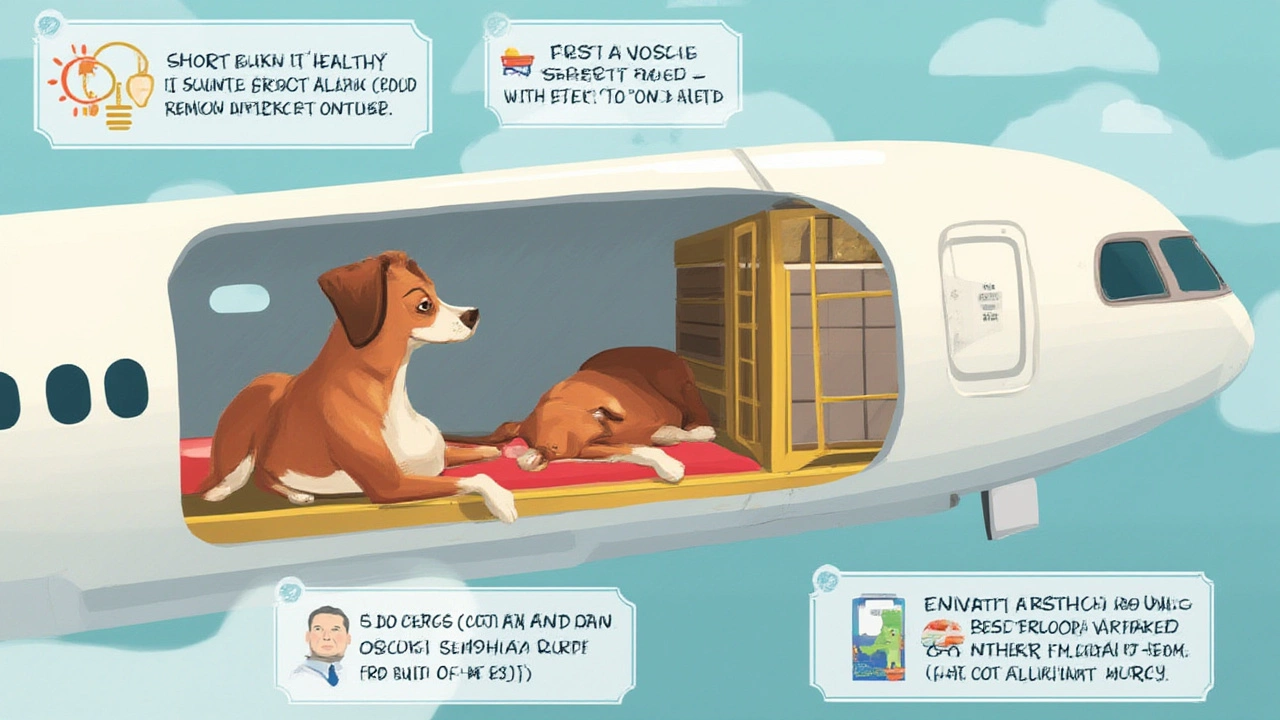
Picture your dog: tail wagging, tongue lolling—and then, a sharp contrast: crated and separated from you, lost somewhere in the belly of a plane. The question lingers for every pet parent facing this reality: how bad is it for a dog to fly in cargo? Could that four-hour flight leave invisible scars? You hear stories online—some sound dramatic, others seem dismissive—and sorting fact from fiction isn’t easy. But the truth hides in the details, and the stakes couldn’t be higher. If you’re like me, even the thought of my best buddy panicking alone below deck is enough to tie my stomach in knots. So, is flying in cargo really traumatic for dogs? Let’s peel back the layers and see what science, vets, airlines—and personal stories—have to say.
What Happens When a Dog Flies in Cargo?
Flying in cargo isn’t like a cozy ride up front. Most commercial airlines put pets in a pressurized, temperature-controlled section of the hold, but the noise, vibration, lights, and strange smells can be jarring. All this comes on top of a long, lonely wait inside a crate. Dogs are loaded onto the plane hours before takeoff and may wait just as long to be reunited with you—sometimes longer if there are customs checks or flight delays.
Vet associations often say healthy adult dogs can generally fly cargo safely. Still, that’s an average. The truth for your dog depends on breed, age, health, and temperament. For a dog that’s used to travel, kennel-trained, generally chill, and in good health, cargo may just mean a long nap with some background noise. For anxious, reactive, elderly, or brachycephalic breeds (like bulldogs or pugs), it can be another story: heightened risk, extra stress, even panic. Airlines actually ban some breeds from cargo for this reason.
Research in Applied Animal Behaviour Science looked at canine stress in air travel and found spikes in heart rate, drooling, and vocalizing—even in dogs with mild temperaments. A study from Helsinki’s Faculty of Veterinary Medicine showed cortisol (stress hormone) levels doubled after a four-hour flight, then took hours to return to baseline. Anecdotal evidence from forums and vet clinics backs this up: most dogs bounce back within a day or two, but a surprising number emerge skittish, refuse crates, or become noise-phobic. My friend Madison’s collie wouldn’t step into a crate for months after a transatlantic flight, even for treats.
The cargo hold itself is a mixed bag—literally. Regulations say the space must be heated or cooled, and most larger airlines in 2025 are competitive about pet safety: Delta, United, Air France, and others publish track records, even live-streaming cargo cameras at major airports. But accidents happen, usually tied to extreme temperatures or poor planning. According to the U.S. Department of Transportation, in 2024, 39 pet injuries or deaths were reported among roughly 400,000 animals flown as cargo—a low rate statistically, but each case is a family tragedy.
So, the physical risks—think injury, dehydration, temperature shock—are relatively low, especially with reputable carriers and short flights. But psychological stress is much more common, and that’s where most trauma lies.
| Risk Factor | Incidence (2024) | Airline Safeguard |
|---|---|---|
| Extreme Temp Injury | 4 cases | Heated/cooled holds, breed restrictions |
| Physical Injury (loading/unloading) | 10 cases | Special handling teams, locked crates |
| Escape from Crate | 12 cases | Crate quality checks |
| Stress-related symptoms | Est. 32% | Comfort crates, soothing pheromones, pre-flight training |
There’s also the sensory overload: turbine roar, changes in cabin pressure, various chemical smells, darkness, and random strangers handling their crate. Imagine yourself in a bathtub-sized box, then multiply the confusion by a hundred for a prey animal used to clear signals and familiar scents.
Some airlines now give live status updates via apps or allow real-time crate tracking (looking at you, Lufthansa and KLM Schiphol). But the physical distance from you—their favorite human—remains the biggest source of stress for most dogs.

How Dogs Experience Stress During Air Cargo Transport
Trauma, when it happens, is usually psychological. That could mean short-term anxiety: panting, shaking, hiding, refusal to eat, or sleep cycle changes. But for some unlucky dogs, especially those with past trauma or natural fearfulness, it can lead to a longer term fear of crates, loud noises, or even car rides. Studies at the University of California Davis (2023) tracked shelter dogs exposed to intense sound stress; 36% showed longer-term behavior changes. The stress from flying cargo can echo those effects.
The most obvious toll is in the hours and days after arrival. Dogs may refuse to drink, seem wiped out, or want to avoid everyone. The American Veterinary Medical Association (AVMA) recommends monitoring for these signs for at least 72 hours after any flight. The same guidelines say most pets are back to baseline within a week, but—it’s not automatic. If your dog was already prone to stress, the effects can linger.
But what determines just how heavy the trauma lands? Start with genetics and temperament. Some breeds—think Border Collies, Jack Russells, Chihuahuas—are just more “wired” than Labradors or Basset Hounds. Age matters, too: senior dogs have less resilience, while young puppies (<16 weeks) are more likely to be scarred by one bad experience. Health conditions compound the risk; a dog with heart trouble or chronic anxiety should never fly cargo.
Next, the length and timing of the journey. Short direct flights, with layovers of less than two hours, are safest. Overnight flights expose dogs to fewer temperature swings but more confusion from disrupted sleep cycles. Delays matter a lot. An extra hour waiting on the tarmac can mean spiraling fear—especially for dogs with bladder issues or separation anxiety. If the destination has a very different time zone, expect a few days of jet lag-like confusion.
Not all stress leaves visible marks. Sometimes it’s subtle—a sudden startle response weeks later, a new resistance to travel, or hesitation to approach a crate. I remember Rowan’s cousin, after a Texas-to-Munich transfer, swearing her golden retriever spent months shadowed by a new, nervous energy. He still avoided shadows and corners for weeks.
One often-overlooked damage is to the human-animal bond itself. If the dog’s first travel experience is scary, it can change how your pup sees all separation. The AVMA and FAS (Fear Free Animal Shelter program) stress the need for trust recovery. Going gentle with touch, using positive reinforcement, and giving ample, predictable routines can help mend that rupture.
The wild swings in how dogs process these journeys mean there’s no single answer to the “cargo trauma” question. But it’s fair to say the average healthy dog, with a proper crate and owner-prepared plans, will likely bounce back—though some stress is almost inevitable.

Making Cargo Flights Less Traumatic: Tips and Alternatives
If you must fly your dog in cargo, preparation is everything. Start crate training weeks ahead of time, using treats, meals, and calm praise to forge a safe-space association. Familiar-scented bedding is gold. A 2022 Barkbox study found that 83% of dogs calmed faster with a blanket or toy from home. Synthetic pheromone sprays, like Adaptil, add another layer of comfort; many airlines recommend spritzing the crate beforehand.
Choose your airline with care. Not all cargo services are created equal. Go for airlines that report pet travel stats, have 24/7 animal care teams, and offer real-time tracking. Book direct flights whenever possible. Avoid peak heat or severe winter months, when delays multiply the risk of temperature swings. Always double-check breed bans—especially if your dog is flat-faced, as some airlines won’t fly them at all for safety reasons.
Talk to your vet before booking. For healthy dogs, some recommend a mild sedative (never a full tranquilizer—these are actually linked to higher death rates mid-flight because they suppress breathing). Your vet might also suggest baby steps: short car rides in the crate, simulated “flights” at home with airplane sounds, and packing high-value chews for post-flight rewards.
On the day of travel, avoid big meals (to reduce upset tummies) and stick to your dog’s usual schedule. Exercise right before the crate goes shut. For extra support, some airports have dedicated pet lounges for check-in and recovery—Frankfurt and Atlanta now both offer them, with water, rest spots, and staff who actually understand canine body language.
What about alternatives to cargo? Explore every option. For small dogs, cabin travel is by far the gentlest. If you’re moving internationally, some countries require 14-day or longer quarantines; factor that potential stress against the flight. There are now private pet travel services—like PetJet and AirPaws—that offer climate-controlled, staff-attended transport, but prices climb fast. For domestic moves, consider driving or even using a professional pet ground transporter when possible.
And what if the worst happens—if your dog emerges truly shaken? Patience is key. Offer “recovery days”: predictable routines, gentle play, simple commands, and quiet cuddling. If fear lingers, look for a vet behaviorist skilled in post-traumatic issues; they may recommend gradual desensitization or safe anti-anxiety meds just until trust is rebuilt.
Here’s a quick checklist for safer, saner cargo flights with dogs:
- Start crate training at least 4 weeks ahead, using familiar bedding and treats
- Book non-stop flights during mild seasons (spring, fall)
- Label the crate with your contact info—and your dog's name
- Pack a travel kit: chew, blanket, water bowl, and calming pheromone spray
- Arrive early; stay calm during check-in
- Track your pet (if the airline offers it), and stay reachable by phone during the flight
- Give your pup a quiet, pressure-free day after the journey
- Monitor closely for any behavior changes and consult your vet as needed
A dog's cargo experience depends on their state of mind, the way you prep, and—honestly—a bit of luck with the airline and weather gods. The more you acknowledge what your dog is feeling, the better you’ll be able to spot signs of trauma and offer comfort. No travel is completely risk-free, but with smart planning, you can dodge a lot of trouble. Most dogs just need someone to have their back—loud engines and strange hands are scary, sure, but knowing you’re waiting at the other end can make all the difference.




